home >
BlogWhat is a Down Jacket?
A Down Jacket is a special type of warm clothing that is insulated with soft and warm feathers from geese or duck to create a fluffy and soft texture with a vast number of tiny air pockets that are able to trap just enough warm air and retain all the heat that the body will need to keep warm during the cold season. These jackets are very popular for their functionality, the warmth they bring to the wearer, and most of all, they are stylish; you can combine them with just about any other type of clothes.
We are going to look at Down Jackets, how to clean and maintain them, the properties that make them stand out, and some of the considerations that one has to keep in mind when shopping for a down jacket. The cold season is fast approaching, and if you are looking for warm clothing, stick to the end and learn a few tips.
There are a number of things that set down jackets apart from other regular jackets. Qualities that you have to keep a close tab on when you are shopping for warm clothing in anticipation of the cold season, the following are the main properties that you should focus your attention on.
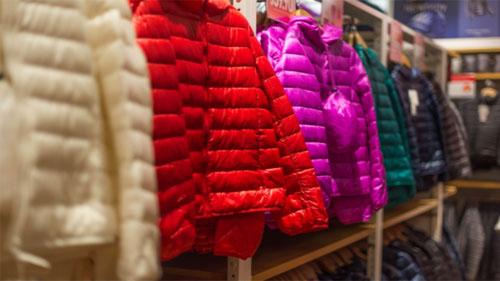
Source: Pixabay
Filling power is the measurement of a down jacket’s loft in relation to the insulation value it holds. When a down jacket is described to have a higher filling power, it means that it has the capacity to trap more air in a specific weight of down, and this creates better insulation for the wearer and vice versa. The filling power rating is measured by computing the cubic inches that an ounce of down can cover. For instance, if a down jacket comes with a rating of 500, it means that for every single ounce of down, 500 cubic inches are covered.
The most common down jackets in the market usually come in a filling power rating of between 500 and 400, but there are some high-end ones that can go as far as 900. To get your hands on the best fit, you will be best placed to get a down jacket with a filling power that is above 500. The colder the region, the higher you should go.
The following is an illustration of the Down jacket filling power ratings.
| FILL POWER | RATING |
|---|---|
| 400 - 450 | Medium |
| 500 - 550 | Good |
| 550 - 750 | Very Good |
| 750 - 900 | Excellent |
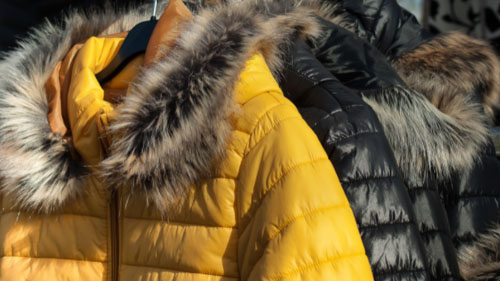
Source: Pixabay
When it comes to clothes, weight matters a lot as you will be spending a lot of time wearing them and you don’t want to be worn down with heavy clothing. Down jackets have to match your requirements, as much as they have to be warm enough, they must be lightweight jackets. Depending on the filling power, a down jacket can either be bulkier or lighter.
In most cases, the higher the filling power, the less bulky the jacket and vice versa. Therefore, take your time to try out several of them to feel the weight first hand before buying it. Make sure everything fits well and nice to avoid creating issues by wearing a jacket that’s too heavy for you.

Source: Unsplash
Every down jacket comes with a percentage of down indication and this affects the insulation abilities of the jacket. The percentage is usually presented as 80/20, 70/30 and so on and it represents the split between down and the feathers. For instance, a percentage rating of 90/10 would mean that the jacket is 90% down and 10% feathers.
The most high-quality down jackets will have a higher down percentage but you should be ready to spend more as they don’t come cheap. Down is always a better insulator; therefore, look for jackets that have a higher down percentage for the best results.
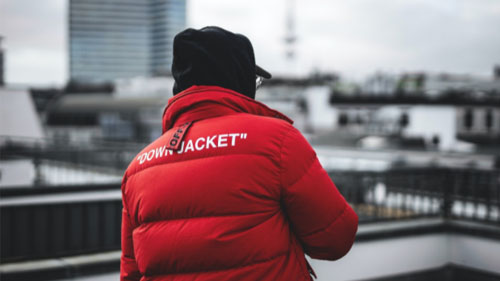
Source: Unsplash
Down jackets use quilting styles in the construction, and this comes in two types. It can either be a Sewn-through baffle or Box baffle. Sewn-through is the most common guilting method used in making down jackets, and it is done by stitching around the edge of the baffle, going through the garment from the outer layer to the inner one.
It is easier to make and holds the down securely in place no matter the pressure or stress that is applied to the jacket. The only major drawback to this method is that it minimizes the space between the inner and outer layers, which limits the space for loft, losing its ability to retain maximum warmth.
Box baffle, on the other hand, is more complicated when it comes to its construction as each baffle has to have its own 3D rectangle. It reduces the pinching near the seams, but this gives it maximum loft that results in better insulation.

Source: Unsplash
Insulation is the whole point of having a down jacket, and therefore, it is the one attribute that has to work more than anything else. A good insulated jacket has the ability to keep the cold out, and at the same time, it should be able to get dry as quickly as possible when it rains.
Insulations come in many types, but the most common ones are synthetic, and they are made using microfiber material that can mimic the real thing but at a lower price. A well-insulated down jacket should be warm, breathable, and lightweight. As more technological advancements keep coming up, the line between synthetic and natural insulation is slowly diminishing.

Source: Unsplash
The lining material is very important in any warm clothing, and the same applies to down jackets. The material used for the shell and lining will affect the durability, warmth, weight, and water resistance at varying levels. Since most down jackets are for outdoor activities, you need to have them lined with breathable and waterproof material that doesn’t trap moisture inside as that will create dampness and foul odor.
Some of the common materials used for the shell and lining are nylon and polyester for the oblivious reason of keeping water out. However, don’t just take our word for it. When purchasing a down jacket, check the lining and the shell attentively, check the stitching and look at the number of layers that have been constructed into the fabric. The more the layers, the longer the lifespan of the jacket.

Source: Unsplash
Quality down jackets are not cheap at all, and getting the right one may set you back a couple of dollars. However, they are worth the purchase. There are many brands and types of down jackets, and each comes with its own rating. Budget jackets can handle all the needs you may have but if you reside in the coldest of climates, then going for the best down jacket in the market is not a matter of choice; it is a necessity.
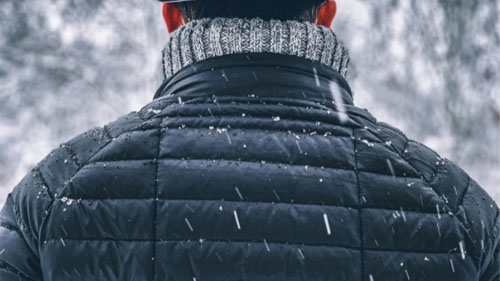
Source: Unsplash
What other features are bundled with the down jacket? You may need a hood that will keep your face warm, especially in places that experience cold winds. However, a hood will add more weight to the jacket, so be aware of that. You can also go for a jacket that comes with cuffed waists and wrists to seal the warmth that tends to escape through the arm areas. You can also go for one that comes with pockets that can be used for shielding hands away from the cold if you are the type that doesn’t love wearing gloves.
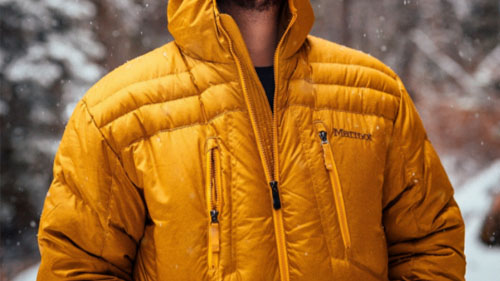
Source: Unsplash
A good down jacket should fit just right. It shouldn’t be too loose as that will cause all the warmth your body accumulates to escape every time you move. It shouldn’t also be very tight as that will limit the breathability and increase the discomfort every time you try to move. Go for a jacket that fits your body just right, and the only way to find out if it is the right fit would be trying it on. You will immediately know if it is the ideal one or not without even being told.
When you consider their construction and their prices, down jackets require special maintenance. They are also very bulky, and once they come into contact with water, they soak it all up and triple in weight, which can pose a severe problem when it comes to washing. But there are ways through which you can clean a down jacket and ensure it doesn’t lose any of its good attributes. The following are some tips you should keep in mind.
At some point, you have to wash your down jacket, this doesn’t have to be every week, but depending on how often you use one, you may have to give a good wash once every two weeks. This is how you do it.
Once all these are seen to, you have to decide if you are going with hand-washing or machine-washing. Each is handled differently using different materials and processes as outlined in detail below. To be clear, hand washing a down jacket is the recommended option.
Drying a down jacket is a delicate process that should be handled with care as this is the point where most people end up destroying it. The following are some quick steps you can follow to ensure the jacket is dried the right way.
For those that may not have access to a tumble dryer, you can dry the jacket out in the open naturally, but you should avoid placing it in direct harsh sunlight. If the conditions outside are not ideal, then simply hang the jacket in a warm room with all the zips open to stop dampness from setting in. Follow the same process of shaking the jacket once it is dry to smoothen out the clumps and get it back to its rightful shape.
Once the jacket is cleaned and dry, the next important thing is storage. If you are not planning to wear it anytime soon, then make sure you store it the right way, and there are good reasons for that. Unlike other types of clothes and jackets, a down jacket is supposed to remain fluffy if it is to function the way it was designed. Packing the jacket badly will cause the feathers to clump up, and that will mark the end of that jacket.
Allow the jacket the space to breathe, don’t wrap it inside an airtight plastic; simply place a light paper over the jacket to protect it from direct light and dust. This is how you ensure that your down jacket stays for longer without sustaining much damage.

Source: Pixabay
As we have already established, down jackets are pretty efficient, but that depends on how you handle them. To ensure that you bet the best out of your down jacket, the following are some of the things you should never do.
A down jacket’s fill-power is tied to everything and will determine how good that jacket turns out to be, especially the weight. Anything that has a fill-power rating of less than 550 is not an ideal jacket to buy, especially if you are planning a trip to some of the coldest regions on the planet. That will basically leave you exposed to the elements. Try as much as you can to get your hands on a down jacket with a higher fill power and one that’s a little heavier as it retains more heat than lighter ones.
A big mistake that people who love going trekking in cold mountainous regions make is that they wear their down jackets when walking up the punitive slopes. This causes their bodies to heat up pretty fast, and all that heat is then trapped inside the down jacket, making them sweat even more, losing valuable energy and water. When trekking, wear something more breathable like a fleece sweater to avoid getting dehydrated quickly. Trekking with your down jacket also exposes it to damage from hanging branches and sharp objects. Only wear your down jacket when you are not moving.
A down jacket is not a raincoat. It may be a little waterproof, but it cannot hold its ground in heavy rain. In fact, many manufacturing companies that claim their down jackets are waterproof are misleading you since what they truly mean is that the jackets are splashproof. When it comes into direct contact with heavy rain, you will be soaked to the bone, and this will make the jacket lose its fluffiness, and once that’s gone, then you wouldn’t have a down jacket to begin with. If you have to put on your down jacket when it is raining, have a raincoat over it too.
Cleanliness is good, but too much of it will destroy our down jacket. When you consider the design of this jacket and the layering that goes into it, and the materials used, then you will understand why even washing is done delicately. If you do choose to wash your jacket, make sure you do it on a sunny day and expose it to direct sunlight at least twice a month to get rid of any moisture build-up and to maintain that fluffiness it is known for. The most important part is the drying; make sure it has been done properly without rushing it through.
Dropping your down jacket to a dry cleaning shop is not recommended since many dry cleaners may not know how to handle a down jacket and end up destroying it in the process. Considering how expensive these jackets are, you are better off handling the cleaning on your own. If you have to have it cleaned by a dry cleaner, make sure you are there when that is being done so that you can give out clear instructions. However, hand washing the jacket on your own is way much better and safer.
Down jackets have a splashproof layer that keeps them dry when water is splashed on them. This layer is pretty delicate, and it can be destroyed by hard detergents, and this is why you are asked to avoid using them during cleaning and maintenance. There is a special type of detergent designed for down jackets that you should use when it comes to cleaning. There are many brands in the market to choose from; take your time to find the one that works for you.
Never fold the down jacket in storage that will clump it up, destroying its fluff attributes and converting it into a regular jacket. The jacket has to be placed on a hanger and stored when standing upright, not inside an air-tight polythene bag. It needs to breathe. This ensures that the feathers remain soft and fluffy as the air moves in and out without any restrictions. Make sure the wardrobe has enough space and is not too cramped. The last thing you would want is to have a jacket that is moldy and smelly.
Once in a while, create time to just air the down jacket out, not necessarily when you have washed it. Find a warm day and hang it out in the sun with all the zips open to allow the wind to blow through and get rid of any mixture build-up. The warmth from direct sunlight will also make the feathers become fluffier, and that will make the jacket become even more reliable.
Down jackets are a very great way of keeping yourself warm when things get icy outside. They are designed for perfection, and when combined with the right maintenance, a down jacket may last you years. There are many brands out there, and getting the right one can be a little tricky; use the guide we have provided for you here to make the right choice. For more information on down jackets and how to maintain them, check out our website when you have time and find all the helpful tips in one place.
